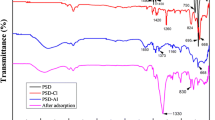Abstract
A new type chelating resin grafted alkylimide was synthesized to investigate uranium(VI) adsorption properties. The chelating resin was characterized by scanning electron microscopy, infrared spectroscopy and mercury intrusion porosimetry. Results showed that the chelating resin was a macroporous resin with the average pore size of 172.8 nm. The maximum adsorption amount could reach 64.9 mg/g when the dosage was 60 mg, the initial U(VI) concentration was 100 mg/L, the pH was 5.0 and the balance time was 48 h. The adsorption process was accorded with pseudo-first-order kinetic model and Freundlich isotherm model, and adsorption process was a spontaneous endothermic reaction.










Similar content being viewed by others
References
Wei X, Liu Q, Zhang H et al (2018) Rapid and efficient uranium(VI) capture by phytic acid/polyaniline/FeOOH composites. J Colloid Interface Sci 511:1–11
Yu HW, Yang SS, Ruan HM et al (2015) Recovery of uranium ions from simulated seawater with palygorskite/amidoxime polyacrylonitrile composite. Appl Clay Sci 111:67–75
Liu J, Zhao CS, Tu H et al (2017) U(VI) adsorption onto cetyltrimethylammonium bromide modified bentonite in the presence of U(VI)-CO3 complexes. Appl Clay Sci 135:64–74
Chen BD, Wang J, Kong LJ et al (2017) Adsorption of uranium from uranium mine contaminated water using phosphate rock apatite (PRA): isotherm, kinetic and characterization studies. Colloid Surf A: Physicochem Eng Asp 520:612–621
Cheng W, Wan T, Wang XH et al (2018) Plasma-grafted polyamine/hydrotalcite as high efficient adsorbents for retention of uranium (VI) from aqueous solutions. Chem Eng J 342:103–111
Saleh TA, Naeemullah Tuzen M et al (2017) Polyethylenimine modified activated carbon as novel magnetic adsorbent for the removal of uranium from aqueous solution. Chem Eng Res Des 117:218–227
Wang YQ, Zhang ZB, Liu YH et al (2012) Adsorption of U(VI) from aqueous solution by the carboxyl-mesoporous carbon. Chem Eng J 198–199:246–253
Tan LC, Liu Q, Jing XY et al (2015) Removal of uranium(VI) ions from aqueous solution by magnetic cobalt ferrite/multiwalled carbon nanotubes composites. Chem Eng J 273:307–315
Xu C, Wang J, Yang T et al (2015) Adsorption of uranium by amidoximated chitosan-grafted polyacrylonitrile, using response surface methodology. Carbohydr Polym 121:79–85
Orabi AH, El-Sheikh EM, Saleh WH et al (2016) Potentiality of uranium adsorption from wet phosphoric acid using amine-impregnated cellulose. J Radiat Res Appl Sci 9(2):193–206
Kenney JPL, Ellis T, Nicol FS et al (2018) The effect of bacterial growth phase and culture concentration on U(VI) removal from aqueous solution. Chem Geol 482:61–71
El-Maghrabi HH, Abdelmaged SM, Nada AA et al (2017) Magnetic graphene based nanocomposite for uranium scavenging. J Hazard Mater 322(Pt B):370–379
Hu L, Yan XW, Zhang XJ et al (2018) Integration of adsorption and reduction for uranium uptake based on SrTiO3/TiO2 electrospun nanofibers. Appl Surf Sci 428:819–824
Özeroğlu C, Bilgiç ÖD (2015) Use of the crosslinked copolymer functionalized with acrylic acid for removal strontium ions from aqueous solutions. J Radioanal Nucl Chem 305:551–565
Venkatesan KA, Shymala KV, Antony MP et al (2008) Batch and dynamic extraction of uranium(VI) from nitric acid medium by commercial phosphinic acid resin, Tulsion CH-96. J Radioanal Nucl Chem 275(3):563–570
Metilda P, Sanghamitra K, Gladis JM et al (2005) Amberlite XAD-4 functionalized with succinic acid for a solid phase extractive preconcentration and separation of uranium(VI). Talanta 66:192–200
Ilaiyaraja P, Deb AKS, Ponraju D et al (2017) Surface engineering of PAMAM-SDB chelating resin with diglycolamic acid (DGA) functional group for efficient sorption of U(VI) and Th(IV) from aqueous medium. J Hazard Mater 328:1–11
Cheira MF (2015) Synthesis of pyridylazo resorcinol—functionalized Amberlite XAD-16 and its characteristics for uranium recovery. J Environ Chem Eng 3(2):642–652
Ferrah N, Abderrahim O, Didi MA et al (2011) Sorption efficiency of a new sorbent towards uranyl: phosphonic acid grafted Merrifield resin. J Radioanal Nucl Chem 289(3):721–730
Liu SD, Yang Y, Liu T et al (2017) Recovery of uranium (VI) from aqueous solution by 2-picolylamine functionalized poly(styrene-co-maleic anhydride) resin. J Colloid Interface Sci 497:385–392
Amphlett JTM, Ogden MD, Foster RI et al (2018) Polyamine functionalised ion exchange resins: synthesis, characterisation and uranyl uptake. Chem Eng J 334:1361–1370
Elwakeel KZ, Atia AA, Guibal E (2014) Fast removal of uranium from aqueous solutions using tetraethylenepentamine modified magnetic chitosan resin. Biores Technol 160:107–114
Qiong Cao, Yaochi Liu, Chunzhi Wang et al (2013) Phosphorus-modified poly(styrene-co-divinylbenzene)-PAMAM chelating resin for the adsorption of uranium(VI) in aqueous. J Hazard Mater 263(Pt 2):311–321
El-sherif RM, Lasheen TA, Jebril EA (2017) Fabrication and characterization of CeO2–TiO2–Fe2O3 magnetic nanoparticles for rapid removal of uranium ions from industrial waste solutions. J Mol Liq 241:260–269
Crane RA, Scott TB (2014) The removal of uranium onto nanoscale zero-valent iron particles in anoxic batch systems. J Nanomater:1–9
Nilchi A, Shariati Dehaghan T, Rasouli Garmarodi S (2013) Kinetics, isotherm and thermodynamics for uranium and thorium ions adsorption from aqueous solutions by crystalline tin oxide nanoparticles. Desalination 321:67–71
Soliman AM, Murad AA, El Sheikh E S et al (2017) Selective removal of uranium from wastewater using sludge collected from refinery wastewater treatment: Equilibrium, thermodynamic and kinetics studies. J Water Proc Eng 19:267–276
Acknowledgements
The study was supported financially by National Nature Science Foundation of China (11375043) and Jiangxi Province Key Subjects Academy and Technique Leaders Funding Project (20172BCB22020).
Author information
Authors and Affiliations
Corresponding author
Rights and permissions
About this article
Cite this article
Liu, Z., Liu, D., Cai, Z. et al. Synthesis of new type dipropyl imide chelating resin and its potential for uranium(VI) adsorption. J Radioanal Nucl Chem 318, 1219–1227 (2018). https://doi.org/10.1007/s10967-018-6143-3
Received:
Published:
Issue Date:
DOI: https://doi.org/10.1007/s10967-018-6143-3



